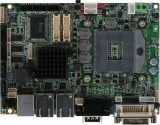AAEON: product
compliance with Intel Intelligent Systems Framework
AAEON has been
recognized for its products’ compliance with Intel’s Intelligent Systems
Framework (ISF). ISF is a standard for computing components introduced to
create a set of inter-operable solutions designed to address connecting,
managing, and securing devices and data in a consistent and scalable manner. It
is able to reduce fragmentation by scaling across applications and bring
together operating systems, tools and hardware in one ecosystem.
According to Intel,
the ISF creates a set of interoperable solutions that can scale across
applications and bring together the hardware, OSs and software that enable
these devices to be remotely managed and provide useful analytics on the data
that is being collected by these systems. This framework consists of profiles
assigned to devices that outline a set of constituents for integration, with
Intel providing a level of integration testing and validation to ensure that
components can interoperate, as expected. If the components pass these tests,
they then can be designated as ISF ready under the assigned profile.
This new approach
has the potential to lower deployment costs, simplify integration and enable
new and innovative services. The resultant effects on vertical markets will be
that Machine (M2M), Internet of Things, and Big Data become more manageable for
system operators and developers. Intel is working with system integrators and
vendors such as AAEON along with software developers to create Cloud-to-Device
services that use the ISF as its foundation.
AAEON’s Intel
Intelligent Systems Framework readiness can be exemplified by these selected
products, which offer a full spectrum of system wide connectivity and ease of
integration. The FWS-7810 for instance, is a 1U Network Appliance featuring
Intel Xeon E3-1200 v3 Series Processor with the Intel C226 Chipset. The
FSW-7810 has been validated by Intel as being compliant with Intelligent
Systems Framework 1.05 Gateway Profile requirements, and will be listed on the
Intelligent Solutions Alliance Solutions directory as “Intelligent Systems
Framework Ready”. In addition, AAEON has released several other ISF Client
approved boards including the COM-QM87, a Type 6 COM Express CPU module with
its 4th Generation Intel Core processor and mobile Intel QM87 Express chipset,
offering low-power and enhanced graphics power over the previous COM Express
CPU modules, the 3.5” GENE-QM87 fully functional single board computer, the
IMBA-Q87A ATX industrial motherboard also powered by a 4th Generation Intel
Core CPU, and the EMB-QM87A Mini-ITX form factor board with a 4th Generation
Intel Core i7/i5 processor. These new ISF certified boards feature Intel vPro
technology, which delivers unprecedented hardware support for vital security
and management functions. For the Edge Profile, AAEON offers the ISF-ready
GENE-TC05, an industrial temperature range single board computer powered by an
Intel E620T to E680T processor.
For AAEON, these
embedded ISF ready products represent the continued effort towards creating
solution-centred products based on Intel architecture that can be used as
modular building blocks in a highly integrated and interoperable real-time
computing environment across a broad range of its client’s applications.
RDS are able to
discuss any requirements you may have with you if needed and provide advice and
support where needed. Get in touch, we may be able to demo some hardware and
even allow you to test your software on a test platform to check suitability.















